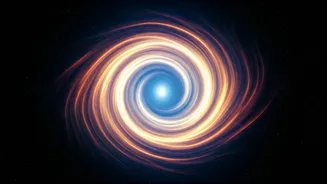Dark Matter's Existence
Dark matter is a hypothetical form of matter that is invisible because it does not interact with light. Its existence is inferred from its gravitational
effects on visible matter, such as galaxies. For instance, observations have found that galaxies spin at speeds that cannot be explained by the visible matter alone, suggesting the presence of a massive, unseen component. Scientists propose that dark matter is composed of non-baryonic matter, meaning it is not made of protons and neutrons. These particles have yet to be directly detected. Despite being undetectable, it makes up about 85% of the total mass in the universe. Understanding dark matter is key to comprehending the formation, structure, and evolution of the universe. This unseen matter plays a crucial role in holding galaxies together and influencing the large-scale structure of cosmic phenomena.
Flattened Dark Matter
Recent studies propose that dark matter may not be uniformly distributed, but could instead be flattened. This hypothesis suggests that dark matter might be concentrated in a disc-like structure, similar to the shape of a galaxy. This flattened distribution has significant implications. One of these is its potential to account for the unexpected gamma-ray glow emanating from the center of the Milky Way. This glow has puzzled astronomers for years, but a flattened dark matter model could provide a more comprehensive explanation. The distribution of dark matter could play a significant role in understanding how our galaxy evolved. Moreover, this model introduces new possibilities for the interaction of dark matter particles with each other and with standard model particles.
Hidden Mirror World
One intriguing possibility linked to the flattened dark matter model is the existence of a hidden 'mirror world.' This concept suggests that there might be another universe, similar to our own, but composed of different particles that do not interact with ordinary matter. These mirror particles could include a mirror form of dark matter. The origin of dark matter might be at the edge of the universe. Dark matter could have originated from a period of symmetry breaking. This idea proposes a link between the known particles and the mirror world. This concept might provide a way to explain the observed properties of dark matter. Furthermore, the mirror world could address several unsolved mysteries in physics, such as the matter-antimatter asymmetry. While the existence of a mirror world remains hypothetical, it offers a fascinating and potentially testable framework for advancing the scientific understanding.
Gamma-Ray Glow Explained
The gamma-ray glow discovered at the center of the Milky Way has puzzled scientists for years. The flattened dark matter model offers a compelling explanation for this phenomenon. According to this model, dark matter particles could collide or decay, producing gamma rays. If dark matter is distributed in a flattened structure, these interactions would be more concentrated, resulting in a stronger gamma-ray signal. This model helps explain the energy spectrum and spatial distribution of the observed gamma rays. Another possibility is that the interaction of dark matter particles in the galactic core generates gamma rays that we can detect. Further investigation and data analysis are important to validate this theory and confirm the nature of the dark matter. The potential link between dark matter and the gamma-ray glow is an active area of research, with ongoing efforts to gather more observational evidence and develop more refined theoretical models.
Detection Challenges Remain
Despite significant progress in understanding dark matter, directly detecting it remains a major challenge. Dark matter does not interact with light or other electromagnetic radiation, which makes it invisible to conventional telescopes and instruments. Scientists have developed various detection experiments, such as those that look for the collision of dark matter particles with ordinary matter. Other methods involve searching for the products that would be emitted when dark matter particles decay or interact. Despite these efforts, direct detection of dark matter has remained elusive. The development of advanced detection technologies and experiments is ongoing. They can enhance the sensitivity to probe the properties of dark matter. Understanding how dark matter behaves is one of the most critical challenges in modern physics and cosmology. The search for a way to detect dark matter will require persistent effort and ingenuity from scientists.











